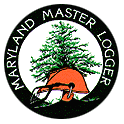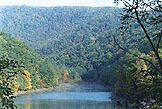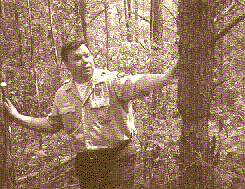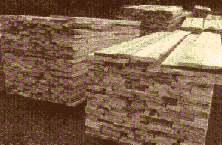MARYLAND'S FORESTS
 Maryland forests are among the most diverse and productive forests on the continent. From the pine flats and cedar-cypress swamps on the Eastern Shore, to the vast oak-hickory forests rolling through the Piedmont and mountains, Marylanders possess an incredibly resilient and valuable renewable resource.
Maryland forests are among the most diverse and productive forests on the continent. From the pine flats and cedar-cypress swamps on the Eastern Shore, to the vast oak-hickory forests rolling through the Piedmont and mountains, Marylanders possess an incredibly resilient and valuable renewable resource.
Maryland forests filter our water, keep our fertile soil in place, moderate our temperature, and cleanse our air. Our forests are habitat to healthy and abundant wildlife populations, provide marvelous aesthetic benefits, and generate a continual supply of raw material for some of the finest furniture, lumber and paper products in the world.
 Our forests are important to our state economy. Private owners like you own 90% of Maryland’s 2.7 million acres of forest. These privately owned forests play a large role in the health of Maryland’s forest products industry. As the fifth largest industry in the State, forest products generate over $1 billion to Maryland’s economy and employs roughly 14,500 persons. This is an “ecologically balanced” industry, renewing its raw material on a sustainable basis, while providing environmental, recreational, and aesthetic benefits to Maryland.
Our forests are important to our state economy. Private owners like you own 90% of Maryland’s 2.7 million acres of forest. These privately owned forests play a large role in the health of Maryland’s forest products industry. As the fifth largest industry in the State, forest products generate over $1 billion to Maryland’s economy and employs roughly 14,500 persons. This is an “ecologically balanced” industry, renewing its raw material on a sustainable basis, while providing environmental, recreational, and aesthetic benefits to Maryland.
Maryland Master Loggers are a vital part of this industry. They understand the many functions of our forests. A Maryland Master Logger understands his role as caretaker of this important renewable resource. A Maryland Master Logger can help you get what you want today without sacrificing the benefits of tomorrow.
THE MARYLAND MASTER LOGGER PROGRAM
The Maryland Master Logger program is a series of comprehensive training courses designed for the logging professional. Program attendance is completely voluntary. The Master Logger Program endorses only those loggers that complete the training agenda.
Initial training covers five areas of significance to the logger. Upon completion of these courses, Master Loggers must attend at least one Continuing Education course each year.
You don’t have to be a logger to attend the classes. Landowners, foresters, and all interested may also attend. Most courses range from $20 to $40.
BEST MANAGEMENT PRACTICES
This course provides the technical information necessary to properly design timber harvests. It includes how to locate stream crossings, stream buffers, skid trails, roads, and landings. These measures all help prevent erosion and sedimentation.
LOGGING AESTHETICS
Many people object to timber harvests simply because they may look bad. This course provides simple, inexpensive methods to improve the appearance of harvests.
FOREST MANAGEMENT
This class discusses the elements of forestry.” Forest Management” presents Forest Science, ecology, and wildlife management in terms of logging production.
FIELD PRACTICUM
Loggers spend the second half of the day in the field. Here they apply principles learned by laying out a simple harvest area on the ground.
LOGGING SAFETY AND OSHA
Logging is a dangerous occupation. Responsible loggers use safe work practices, avoiding injury to themselves and others. This course covers general safety, safety equipment, communications, and operating procedures. The course also covers the specific requirements of the Occupational Safety and Health Administration (OSHA).
FIRST AID AND CPR
The OSHA law requires that all crew members have this training. Accidents can happen at anytime, and most logging jobs are in remote areas. Therefore the assistance an injured worker receives is of critical importance.
CONTINUING EDUCATION
At least once each year, a Master Logger will attend one additional course on a topic related to his profession. Log grading and marketing, environmental regulations, deed and title research, trucking safety, and timber estimations are some of the courses that may be offered.
Periodic Job site visits may be held to maintain Master Logger designation.
MANAGEMENT IS THE KEY
 Your forest is an intricate system governed by countless natural forces. Nature often produces results that are of little or no benefit to you. A forest management plan will help guide your forest so that it produces the results you desire.
Your forest is an intricate system governed by countless natural forces. Nature often produces results that are of little or no benefit to you. A forest management plan will help guide your forest so that it produces the results you desire.
A professional forester can help you with developing your forest management plan. The forester will match your goals with the capabilities of your forest and create a long-term plan to reach your goals.
Forest management plans frequently prescribe timber harvesting. Timber harvests do more than just provide income, they lay the foundations for the next generation forest growth. For example, a selection harvest will help retain certain mast-producing hardwoods for wildlife. Clearcuts allow for maximum sunlight needed to regenerate pioneer species, such as pine or yellow poplar.
Obviously, timber harvests also play a role in the financial part of your forest management plan. Do you want to maximize your short-term income? Maybe you’d rather have a continual flow of income on a regular basis? What are your current and future financial needs? Is the financial return on your forest investment the primary or secondary management goal? All of these questions have a direct impact on your timber harvests. A professional forester can help you plan your forest accordingly. A Maryland Master Logger can help you implement your plan.
TIMBER HARVESTS: A LONG TERM PROPOSAL
Timber harvesting creates long-lasting impacts. Harvesting mistakes can take years to fix and can be costly. A well-planned harvest provides you with benefits today, and improves your woodlands for tomorrow. Choosing a Maryland Master Logger is an essential part of your timber harvest.
Timber harvesting is an important tool in forest management. A properly timed and well-executed harvest can help you manage the many values of your forest, including income. A poorly timed or executed harvest can cost you money and reduce the other values of your forest.
An immediate financial loss can come from cutting timber either too early or too late. Damage to the residual stand or soil will adversely affect the future value of your forest. To avoid potential setbacks, you should enlist the services of a qualified forester and a conscientious, professional logger. This team will work cooperatively to fulfill you current objectives and protect your future values.
Maryland’s Master Logger program offers instruction in forest management principles, forest ecology, proper harvest design and layout, safety practices, and life-saving skills.
CONTINUING EDUCATION
Maryland’s Master Loggers must also attend Continuing Education courses to maintain their status. This requirement ensures that the Master Logger you choose has knowledge of the most current laws and techniques in the industry. The Directory of Master Loggers is updated biannually. This ensures the most current listing of Master Loggers possible.

A list of Consulting Forester is also available from the Maryland DNR Forest Service. A Maryland Master Logger, paired with a good forester will ensure that you get the results you want from your forest.
HARVEST METHODS
Your forester can explain proper harvest methods to you, as well as the differences between logging methods and their relevance to the value of your timber and land.
Landowners concerned with aesthetic quality following the harvest, or those looking for periodic cash flows, may choose single-tree selection. This method also helps maintain a steady supply of mast-producing trees of various ages. Single-tree selection requires skill to properly employ since choosing the wrong trees will leave a stand of low quality, low value trees. (This is called “highgrading,” or “cutting the best and leaving the rest”).
Clearcutting generates the most money up front, but less frequently. Clearcutting harvests all the trees at once, creating the full sunlight environment favored by shade intolerant species (such as pine and yellow poplar) that quickly grow in open lands. Many people don’t care for the visual impacts of clearcuts. Strategically located buffers and proper harvest layout can minimize the visual impacts of clearcuts. In a few short years, you will notice a young healthy forest growing.
Group selections are small clearcuts scattered throughout a stand. This method also favors regeneration of the fast-growing “sun-loving” species. Because this method harvests forests patch by patch, the visual impact is less severe. This continual harvesting also yields a steady income.
Shelterwood harvests leave enough trees behind to produce adequate seed to start the new forest growing. The remaining trees also provide the young seedlings with protection from the sun and wind. Seed tree harvests are every similar, except they leave just enough trees to supply adequate seed to regenerate the next forest. Seed tree harvests are best for trees requiring full sunlight, such as pine. In both shelterwood and seed tree harvests, the harvesting of remaining trees a few years later may cause some damage to the new crop of trees. Talk with your forester about these harvesting methods.
Thinnings are intermediate harvests designed to improve the quality of the remaining forest. Often there are just too many trees in a forest and there are not enough nutrients, water, or light to go around. Thinning removes the competition and focuses on the growth of the highest quality trees.
Each forest is different. Landowners should take benefits as well as drawbacks into consideration. A forester and a Maryland Master Logger can help you determine which timber harvest method best suits your needs.
MARKETING YOUR TIMBER
A qualified forester can help you get the best value for you timber. The best deal for you may be the most money up front. It could be steady income. What about long-term benefits? A forester can help you get the result you want.
Services typically provided by a forester include:

- Location boundary lines
- Preparing a forest management plan
- Estimating how much timber you have
- Estimating the worth of your timber
- Assessing market and timing harvests
- Preparing and marketing timber sales packages
- Developing a sale contract
- Supervision of the logging operation
- Obtaining necessary permits
- Periodic inspections to insure the logging job is conducted according to the sales agreement.
WHAT MAKES A GOOD CONTRACT?
A good timber sale contract is necessary to avoid potential misunderstandings and conflicts in the future. Essentially, a good contract will address four issues: the timber being sold, the terms and price, limitations on the logging operation, and measures for protection of your property.
The contract should very clearly explain which timber is being sold as well as which timber is not being sold. The contract should specify the price being paid for the timber and exactly when and how you will be paid.
The contract should indicate measures for the protection of any timber you’re not selling. The contract should also call for the protection of your soil and streams by using Best Management Practices.
Your future forest depends on the success of today’s contract.
ECOLOGICAL CONSIDERATIONS
A Maryland Master Logger can explain what precautions you should take to avoid damaging the quality of your streams and ponds. The Master Logger Program trains loggers in pre harvest planning, road layout, and site closure.
Logging can greatly impact water quality when improperly executed. Proper planning is the key to an environmentally sound operation. Knowing where streams, erosion sensitive soil, and steep slopes are beforehand is a must. Felling trees actually has no impact on water quality. It’s the construction and maintenance of reads, skid trails, and landings that impact water quality. Only exposed soil can erode. Knowing how to minimize soil exposure and controlling water flow is important in preventing erosion.
Harvest planning is a balancing act. Too many landings unnecessarily expose soil and create an erosion hazard. Not enough landings will create an inefficient harvest and could cause more damage in the ling term. Road grades should be moderate, culverts and bridges properly installed, and road surfaces crowned. Toads and trails should be only as long and wide and necessary.
A Maryland Master Logger can explain to you the key elements of your well-planned harvest.
WHERE TO LOOK
The Maryland Department of Natural Resources-Forest Service can provide you with a list of current consulting foresters. A forester is an invaluable component of your management decisions.
The Master Logger Program updates its Directory of Maryland Master Loggers on a regular basis. These professional loggers have voluntarily completed the training regimen of the Maryland Master Logger Program.
For further information about the Maryland Master Logger Program contact:
John Hooven
Woodland Stewardship Educator/Logger Education Coordinator
University of Maryland Extension
Wye Research and Education Center
124 Wye Narrows Drive
Queenstown, MD 21658-0169
tel 410.827.8056 x125 | mobile 410.310.8445 | fax 410-827-9039
Email:
[email protected]